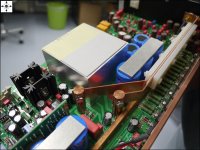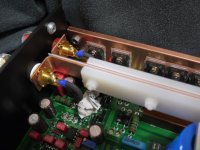Only if you think in terms of physical contacts, perhaps. Such as relay contacts and oxides on the contact surfaces which can be mechanically broken thru.
If there is an N (copper) and a P (oxide) then an N (copper) again there is a continuous voltage drop across the copper/oxide/copper path. That oxide level break-thru voltage could be a potential issue over time. Keeping an open mind about it.
When you consider a new copper penny coin's color and the change in color after only a few days.... we are all listening to heavily oxidated copper wires. Historically, the High-End solution is to not try to measure it so much as to just eliminate it... enter OFHC.
THx-RNMarsh
Richard, your argument falls apart like a cheap suit...what does a new penny have to do with copper?😕
jn
It also falls apart because the strands are roughly equipotential. Series and parallel are not the same thing.
Richard, your argument falls apart like a cheap suit...what does a new penny have to do with copper?😕
jn
It has a LOT to do with how fast the metal oxidizes. Just a few days... compared to how old your wires may be. [and the penny is Not the argument being discussed]
-RM
Last edited:
It also falls apart because the strands are roughly equipotential. Series and parallel are not the same thing.
assuming no broken strands along the length?
-RNM
It has a LOT to do with how fast the metal oxidizes. Just a few days... compared to how old your wires may be.
-RM
Un, Richard...there's no "pulling your leg" emoticon. I tried with the confused one.
jn
assuming no broken strands along the length?
-RNM
If you have a lot of broken strands, the oxidation is the least of your worries.
It also falls apart because the strands are roughly equipotential. Series and parallel are not the same thing.
Circumferential paths are equipotential. Radial paths are not, as a consequence of faraday's law of induction.
I thought I already said that?😕
jn
What ever, IF oxidation is there and it is... then just use OFHC. Or, seal the pcb traces etc. etc.
THx-RNMarsh
THx-RNMarsh
If you have a lot of broken strands, the oxidation is the least of your worries.
Probably true.... but you will never know unless you open and pull out each strand to see how many have broke over flex/time.
practical stuff.
THx-RNMarsh
Circumferential paths are equipotential. Radial paths are not, as a consequence of faraday's law of induction.
I thought I already said that?😕
jn
makes sense to me.
-RM
Cables
Why is a PreAmp thread in Lounge ?
******
Does it make ANY difference if the current is AC or DC ? Power cables / Audio cables.
Anyway, the snake oil vendors are going to have a field with this 😀
Yeah, who can forget !
Except that insulated cables therefore aren't exposed to the air, shouldn't suffer. Many times i've cut several inches etc off years old cables to replug etc them, & the copper is as new !
Why is a PreAmp thread in Lounge ?
******
Does it make ANY difference if the current is AC or DC ? Power cables / Audio cables.
Anyway, the snake oil vendors are going to have a field with this 😀
Yeah, who can forget !
Don't forget, the terminal voltage of a system is:
V = L dI/dt + I dL/dt
.Originally Posted by RNMarsh
When you consider a new copper penny coin's color and the change in color after only a few days.... we are all listening to heavily oxidated copper wires
Except that insulated cables therefore aren't exposed to the air, shouldn't suffer. Many times i've cut several inches etc off years old cables to replug etc them, & the copper is as new !
Left photo has a lot of oxidation... right one a little better.
Ultra-Pure copper BTW is a pale pink color. Yours are turning dark brownish... oxidation. but they are power bars (?) and not signal wires. And you have good air tight connections.
Anyway, time to go beddy-by. Just something to think and talk about --
THx-RNMarsh
Ultra-Pure copper BTW is a pale pink color. Yours are turning dark brownish... oxidation. but they are power bars (?) and not signal wires. And you have good air tight connections.
Anyway, time to go beddy-by. Just something to think and talk about --
THx-RNMarsh
Last edited:
Except that insulated cables therefore aren't exposed to the air, shouldn't suffer. Many times i've cut several inches etc off years old cables to replug etc them, & the copper is as new !
I have found that often to be true also..... but not always has it been true.
-RNM
What ever, IF oxidation is there and it is... then just use OFHC. Or, seal the pcb traces etc. etc.
OFHC will oxidize just as readily as ETP. Also, copper oxide will act as a barrier to prevent further oxidation.
se
Just sell Richard some oxygen free Gold wires and he will be set to go! 😀
😛
Funny thing is, even if you look at copper-clad steel coax, it doesn't exhibit any nonlinearities above -145dB.
se
SE,
I was only being facetious, I really expect that Richard is just messing with us. I have cut wire open even in an automotive environment that were 40 plus years old and the copper wires looked fine. Now if I was on a sailboat I might be a bit more careful in a saltwater environment but otherwise I see this all as a red herring.
I was only being facetious, I really expect that Richard is just messing with us. I have cut wire open even in an automotive environment that were 40 plus years old and the copper wires looked fine. Now if I was on a sailboat I might be a bit more careful in a saltwater environment but otherwise I see this all as a red herring.
JNeutron...re-written. Sorry about that:
What happens if you have wire that is either pulled or extruded,the former striae along its axis, the latter other radially and normal to the axis? After oxidation, don't these produce boundary conditions which could be described a "semiconductor" or "Capacities" ? Would these not affect the signals propagating down the wire?
I see you are all talking about this, just wanted to clarify my question.
What happens if you have wire that is either pulled or extruded,the former striae along its axis, the latter other radially and normal to the axis? After oxidation, don't these produce boundary conditions which could be described a "semiconductor" or "Capacities" ? Would these not affect the signals propagating down the wire?
I see you are all talking about this, just wanted to clarify my question.
Concerning the BeO. I was asking for a thermal conductive polymer, not BeO. We build lasers here, mainly for defense applications and use these toxic materials and have the needed precautions implemented.
- Status
- Not open for further replies.
- Home
- Member Areas
- The Lounge
- John Curl's Blowtorch preamplifier part II

